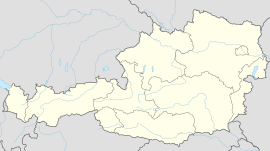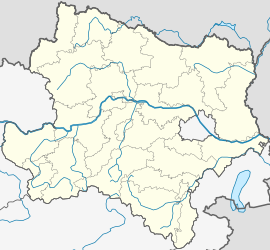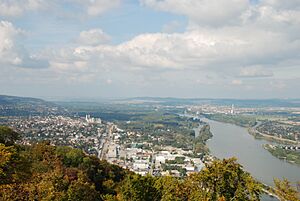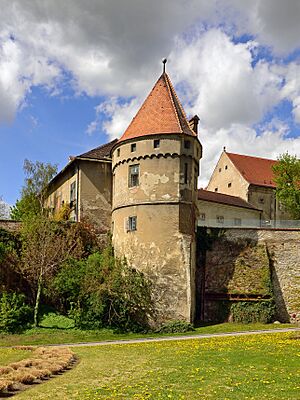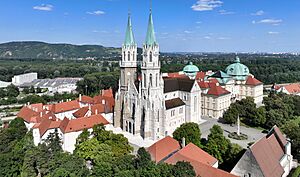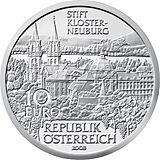Klosterneuburg facts for kids
Quick facts for kids
Klosterneuburg
|
|||
|---|---|---|---|
|
Municipality
|
|||
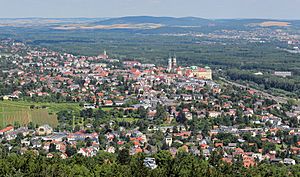 |
|||
|
|||
| Country | Austria | ||
| State | Lower Austria | ||
| District | Tulln | ||
| Area | |||
| • Total | 76.2 km2 (29.4 sq mi) | ||
| Elevation | 192 m (630 ft) | ||
| Population
(2018-01-01)
|
|||
| • Total | 27,058 | ||
| • Density | 355.09/km2 (919.7/sq mi) | ||
| Time zone | UTC+1 (CET) | ||
| • Summer (DST) | UTC+2 (CEST) | ||
| Postal code |
340x
|
||
| Area code | 02243 | ||
| Vehicle registration | KG | ||
| Website | www.klosterneuburg.at | ||
Klosterneuburg (often called Kloburg by people who live there) is a town in Austria. It's located in the Lower Austria state, within the Tulln District. About 27,500 people live here. One of the most important places in Klosterneuburg is the Klosterneuburg Monastery. This monastery was built in 1114 and later given to the Augustinians, a group of religious canons.
Contents
Exploring Klosterneuburg's Location
Klosterneuburg is right next to Vienna, the capital city of Austria. It sits on the Danube River. The Kahlenberg and Leopoldsberg hills, which are part of the Vienna Woods, separate it from Vienna.
Long ago, Klosterneuburg was connected to its "twin city," Korneuburg. Korneuburg is on the other side of the Danube. But the river changed its path during the Middle Ages, separating the two towns. Today, a special ferry called a reaction ferry connects them. This ferry runs during the day from spring to late autumn.
Nature and Hills Around Town
The town area includes the northern tip of the Donauinsel (Danube Island). It also has a mountain called Mt. Exelberg, which is 515 meters (1,690 feet) high. There's a tall telecommunication tower on top of it.
Klosterneuburg is known for its wine growing. You can find many respected winemakers here. There are also many Heuriger wine taverns, which are places where winemakers serve their new wine. The Federal Institute for Viticulture and Pomology (a special school for wine and fruit growing) is also in town. This is where Fritz Zweigelt created the famous Zweigelt and Blauburger red wine grapes.
Town Layout and Connection to Vienna
Because Klosterneuburg is built on hills, it has several different areas. These areas are called cadastral communities. They include Klosterneuburg-Stadt, Maria Gugging, Höflein an der Donau, Kierling, Kritzendorf, Weidling, and Weidlingbach. The town center has two main shopping areas: the Stadtplatz/Niedermarkt and the Rathausplatz. A steep hill separates these two areas.
The town is very close to Vienna. Many people who live in Klosterneuburg work in Vienna. You can get to Vienna easily by highway (B14), by train (the S40 line), or by bicycle on the EV6 The Rivers cycle path. Klosterneuburg also has some light industries. Even though it's not part of Vienna, it feels a bit like a suburb of the capital. From 1938 to 1954, Klosterneuburg was actually considered Vienna's 26th district. Some people have even suggested it should become part of Vienna again.
Important places like the Albertina Klosterneuburg and the Institute of Science and Technology Austria, which started in 2006, are located in the town.
A Look at Klosterneuburg's Past
We know people lived in this area a very long time ago, even during the Neolithic period (the New Stone Age). During the Roman Empire (from the 1st to 5th centuries), a Roman fort stood here. It was part of the limes, which was the border defense system along the Danube.
Klosterneuburg was first mentioned in a document in 1108. It was called Nivvenburc, which means "New Castle."
The Babenberg Rulers and the Monastery
In 1113, Leopold III of the House of Babenberg family made Klosterneuburg his home. He later became the patron saint of Austria. In 1114, Leopold built a castle and a church on a hill next to the Danube. In 1133, he gave this church to the Augustinian canons. This religious order became one of the oldest and richest in Austria. They owned a lot of land, including parts of what are now Vienna's suburbs.
Later, Duke Leopold VI of Austria (who died in 1230) also lived here for some time. Sadly, his oldest son died here after falling from a tree. The monastery complex is very impressive. It includes an old chapel from 1318 with Leopold's tomb and the famous Verdun Altar from the 12th century. There's also a treasury, a library with thousands of books and old writings, a picture gallery, and a huge wine cellar.
Town Development and Challenges
The market town on the left bank of the river grew quickly alongside the famous monastery on the right bank. The Danube River was important for trade, but it also caused many floods for the people living there.
By the late 1200s, the two parts of the town, Klosterneuburg (the monastery area) and Korneuburg (the market area), had grown apart. Because of this, King Albert I of Germany of the House of Habsburg gave Klosterneuburg its own special town privileges in 1298.
Wars and Changes Over Time
The "Untere Stadt" (lower town), which was not fortified, was destroyed by Ottoman forces during the 1529 Siege of Vienna and the 1683 Battle of Vienna. However, the "Obere Stadt" (upper town), which had strong defenses, was successfully protected both times.
In the 18th century, Emperor Charles VI wanted to rebuild the Klosterneuburg monastery. He planned to make it look like the grand Escorial building in Spain. Construction of the new Baroque buildings began in 1730, but it was never fully finished.
After Austria lost the 1805 Battle of Austerlitz, Napoleon's troops occupied the town until 1809. In the 19th century, Klosterneuburg was mainly a town for winemakers. Later, it became a popular place for Austrian officials to live and relax, especially those working in nearby Vienna.
During the Anschluss (when Austria was joined with Nazi Germany) from 1938, Klosterneuburg became the 26th district of "Greater Vienna." This change was reversed in 1954. At the end of 2016, Klosterneuburg became part of the Tulln District.
Sister City Connection
Klosterneuburg has a special friendship with another city, called a twin town:
Famous People from Klosterneuburg
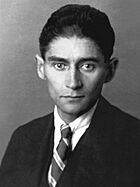

Many interesting people have lived in or had connections to Klosterneuburg:
- Otto of Freising (c.1114–1158), a churchman and historian.
- Johann Georg Albrechtsberger (1736–1809), a composer and music teacher.
- Leopold Trattinnick (1764–1849), a botanist who studied plants and fungi.
- Nikolaus Lenau (1802–1850), a poet buried in the Weidling cemetery.
- Alphons Leopold Mielich (1863–1929), a painter known for scenes from the Middle East.
- Walter Breisky (1871–1944), a politician and former Austrian chancellor.
- Hans Ledwinka (1878–1967), a designer of automobiles.
- Franz Kafka (1883–1924), a very famous author, who died in Kierling.
- Pius Parsch (1884–1954), a priest.
- Wolfgang Hoffmann (1900-1969), an architect and designer.
- Ernst Plischke (1903–1992), an architect from Austria and New Zealand.
- Karl Rahm (1907–1947), an SS officer.
- Roman Karl Scholz (1912–1944), a local Augustinian canon and resistance activist.
- O. W. Fischer (1915–2004), a film and theatre actor.
- Hilde Gueden (1917-1988), an Austrian opera singer.
- Leo Navratil (1921—2006), a psychiatrist.
- Gustav Peichl (1928—2019), an architect.
- Siegfried Selberherr (born 1955), a scientist in microelectronics.
- Karlheinz Essl, Jr. (born 1960), a composer and teacher.
- Johanna Mikl-Leitner (born 1964), a politician and current governor of Lower Austria.
- Thomas Aigner (born 1964), a TV entertainer and film producer.
- Martin Nowak (born 1965), a biologist and mathematician.
Sports Stars
- Helmut Senekowitsch (1933–2007), a footballer who played many games for Austria.
- Gerhard Seibold (born 1943), an Austrian sprint canoeist who won a bronze medal at the 1968 Olympics.
- Herbert Prohaska (born 1955), a famous footballer who played many games for Austria.
- Michael Konsel (born 1962), a football goalkeeper who also played for Austria.
Klosterneuburg on a Coin
Klosterneuburg was chosen to be featured on a special collector's coin. This coin is a high-value commemorative coin. One side of the coin shows a view of the abbey from the slopes of the Leopoldsberg hill. You can see the old Romanesque and Gothic church, as well as its copper dome with the imperial crown.
See also
 In Spanish: Klosterneuburg para niños
In Spanish: Klosterneuburg para niños



